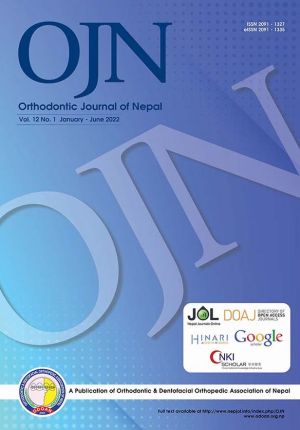Comparison of Salivary Leptin Levels Between Underweight and Overweight Individuals and Its Role in Orthodontic Tooth Movement
DOI:
https://doi.org/10.3126/ojn.v12i1.47488Keywords:
Salivary Leptin, Inflammatory Mediator, Orthodontic Tooth MovementAbstract
Introduction: The Aim of this study is to compare the concentration of salivary leptin levels between underweight and overweight individuals and its significance in orthodontic tooth movement. Methods: Fourty five underweight and overweight female subjects.
Materials and Method: Fourty five underweight and overweight female subjects were taken in this study and they are divided into two groups, group I (underweight) and group II (overweight) depending on their mean body mass index. Angles class I malocclusion with bimaxillary protrusion were taken into this study. All subjects underwent upper first premolar extraction, and distal force is applied with lacebacks to maxillary canine. Salivary leptin samples were collected before force application (To), one hour after appliance placement T2, and one month after appliance placement (T3).
Result: Overweight individuals show increased salivary leptin concentration three times greater than underweight individuals. Orthodontic tooth movement is decreased in overweight individuals when compared with underweight individuals.
Conclusion: Increased salivary leptin levels showed a decreased tooth movement in overweight individuals than underweight individuals who showed decreased salivary leptin levels. Obese individuals require more orthodontic treatment duration time when compared with lean individuals.
Downloads
Downloads
Published
How to Cite
Issue
Section
License
Copyright (c) 2022 Orthodontic & Dentofacial Orthopedic Association of Nepal

This work is licensed under a Creative Commons Attribution 4.0 International License.
Copyright © held by Orthodontic & Dentofacial Orthopedic Association of Nepal
- Copyright on any research article is transferred in full to the Orthodontic & Dentofacial Orthopedic Association of Nepal upon publication in the journal. The copyright transfer includes the right to reproduce and distribute the article in any form of reproduction (printing, electronic media or any other form).
- Articles in the Orthodontic Journal of Nepal are Open Access articles published under the Creative Commons CC BY License (https://creativecommons.org/licenses/by/4.0/)
- This license permits use, distribution and reproduction in any medium, provided the original work is properly cited.




